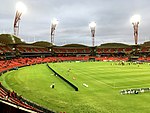Homebush Street Circuit
2009 establishments in Australia2016 disestablishments in AustraliaDefunct motorsport venues in AustraliaFormer Supercars Championship circuitsMotorsport venues in New South Wales ... and 2 more
Sports venues in SydneyUse Australian English from October 2011

The Homebush Street Circuit, also known as the Sydney Olympic Park Street Circuit, was a 3.420 km (2.125 mi) temporary street circuit around the former Olympic precinct at Sydney Olympic Park, Homebush Bay, Australia. The track hosted the Sydney 500 and was used for the first time at the final round of the 2009 V8 Supercar Championship Series. The circuit was used for the final time in December 2016 due to a relocation to a Newcastle after it was announced the ANZ stadium precinct would be upgraded and block the track location.
Excerpt from the Wikipedia article Homebush Street Circuit (License: CC BY-SA 3.0, Authors, Images).Homebush Street Circuit
Orana Parade, Sydney Sydney Olympic Park
Geographical coordinates (GPS) Address Nearby Places Show on map
Geographical coordinates (GPS)
| Latitude | Longitude |
|---|---|
| N -33.844722222222 ° | E 151.06611111111 ° |
Address
Orana Parade
Orana Parade
2127 Sydney, Sydney Olympic Park
New South Wales, Australia
Open on Google Maps










